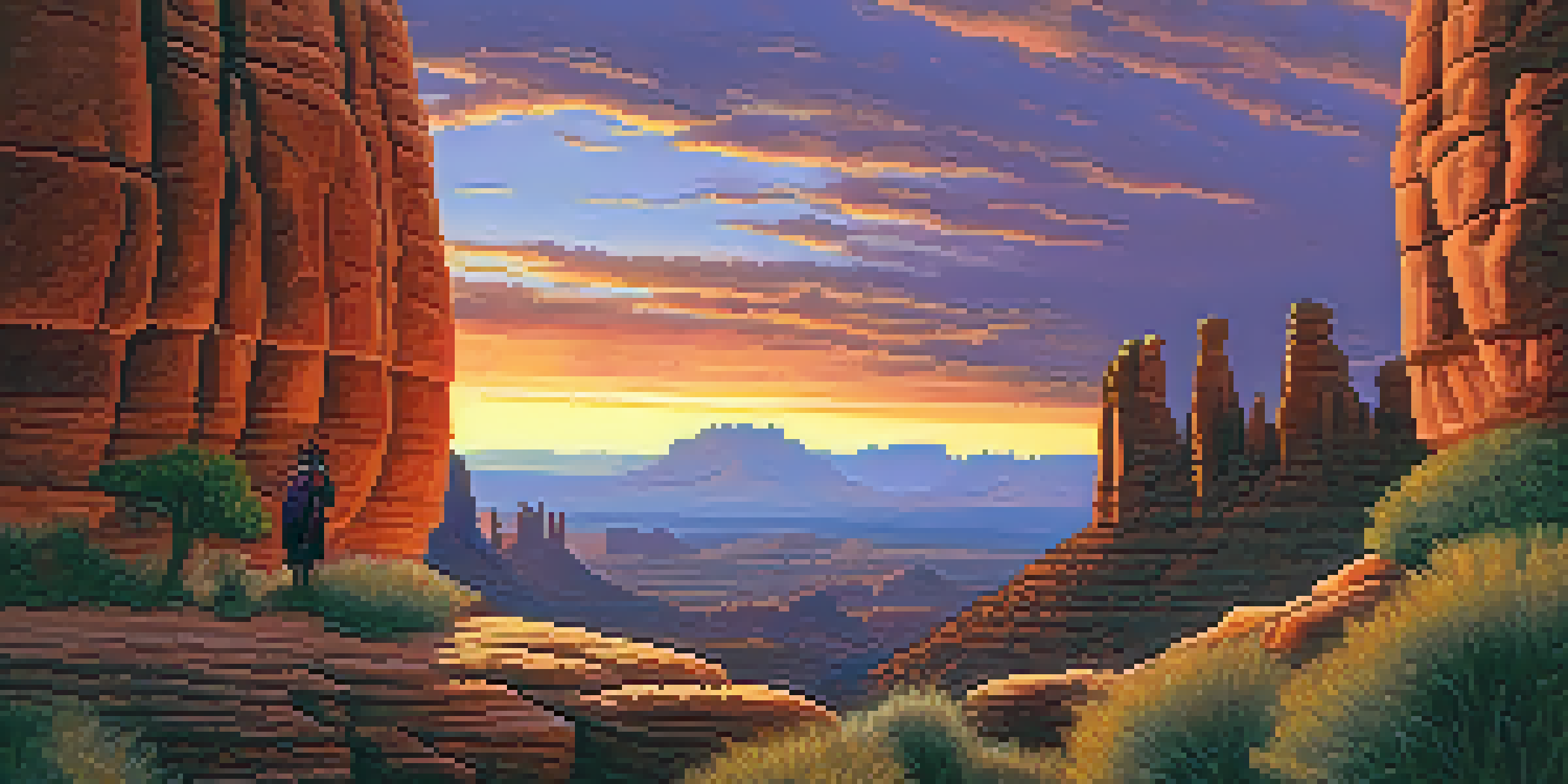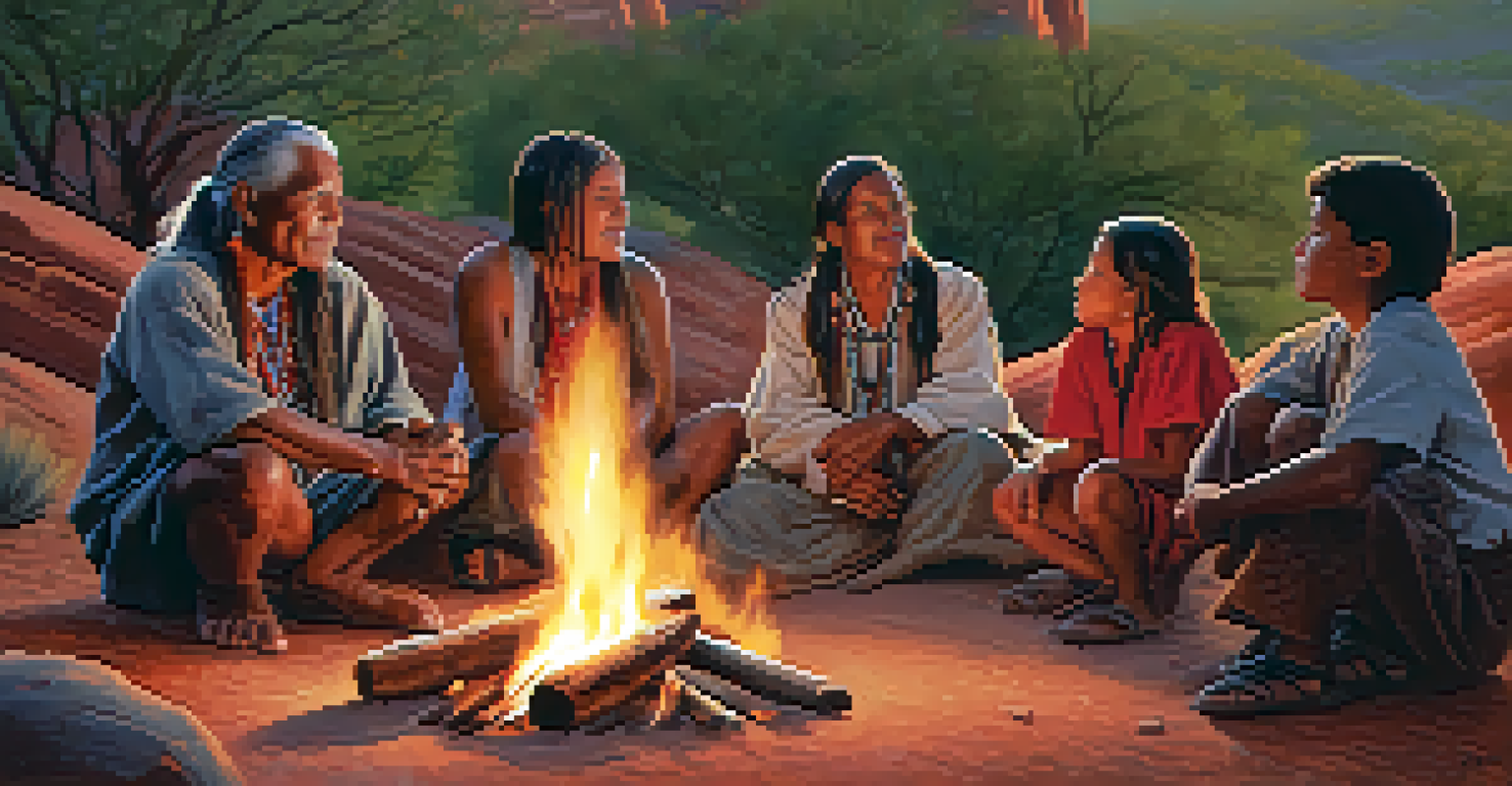Historical Overview of Native American Tribes in Sedona

Introduction to Native American Presence in Sedona
Sedona, Arizona, is not just known for its stunning red rock formations, but also for its deep Native American roots. Various tribes have called this region home for centuries, each contributing to the area's rich cultural tapestry. The Indigenous peoples who inhabited this land had a profound understanding of nature and a unique way of life that shaped their communities.
We do not inherit the earth from our ancestors; we borrow it from our children.
Among the tribes that have a historical presence in Sedona are the Yavapai and the Apache. These tribes utilized the natural resources around them, practicing sustainable living that respected the environment. Their traditions and spiritual beliefs are intricately tied to the land, making Sedona a significant cultural landmark.
Understanding the history of Native American tribes in Sedona allows us to appreciate the land's significance beyond its physical beauty. It invites us to listen to the stories of these tribes and recognize their enduring legacy in the region. By exploring this history, we can foster a deeper connection to Sedona's rich heritage.
The Yavapai Tribe: Guardians of the Land
The Yavapai tribe, known for their rich history and connection to the land, played a crucial role in the Sedona area. They were primarily hunter-gatherers, living off the abundant resources provided by the diverse ecosystems. Their deep understanding of the environment allowed them to thrive in the rugged landscapes surrounding Sedona.

Yavapai culture is deeply rooted in storytelling and spirituality, with many traditions passed down through generations. Their connection to the land is reflected in their ceremonies, which often celebrate the changing seasons and the cycles of nature. This spiritual bond with the earth highlights their role as guardians of the region.
Native Tribes' Rich Heritage in Sedona
Sedona's landscape is deeply intertwined with the histories and cultural practices of Indigenous tribes like the Yavapai and Apache.
Today, the Yavapai people continue to honor their heritage while adapting to modern challenges. Their efforts to preserve their culture and share their stories with others are vital in keeping their history alive. By acknowledging the Yavapai tribe, we recognize the integral part they play in Sedona's identity.
The Apache Tribe: Warriors and Innovators
The Apache tribe, known for their fierce warrior spirit, also had a significant presence in the Sedona region. They were skilled hunters and gatherers, adapting their lifestyle to the changing landscapes. Their resilience and resourcefulness allowed them to navigate the challenges of their environment with great success.
The land is sacred. It is the life blood of our culture and our identity.
Apache traditions emphasize respect for nature and community, with a strong emphasis on family ties. They have a rich oral history that recounts their struggles and triumphs, providing insight into their way of life. The Apache's innovative approaches to conflict and survival have left a lasting impact on the region's history.
In modern times, the Apache tribe continues to celebrate their culture through art, music, and storytelling. They actively engage in efforts to educate others about their history and traditions. Understanding the Apache's contributions helps us appreciate the diverse cultural landscape of Sedona.
Cultural Significance of Sedona to Native American Tribes
Sedona holds profound cultural significance for Native American tribes, serving as a sacred landscape. The area's stunning formations and natural beauty are not just visually striking; they are considered spiritual sites that connect the tribes to their ancestors. Many of these sites are used for rituals and ceremonies that honor their heritage.
The concept of 'vortexes' in Sedona is particularly interesting to many Indigenous cultures. These energy centers are believed to enhance spiritual experiences and promote healing. For Native Americans, these places are not merely tourist attractions but are imbued with sacred meaning and purpose.
Impact of Colonization on Tribes
Colonization profoundly disrupted the traditional lifestyles of Native American tribes in Sedona, leading to significant cultural and population changes.
Recognizing the cultural significance of Sedona encourages visitors to approach the land with respect and reverence. It invites us to learn from the tribes about their spiritual connections to the space, fostering a deeper understanding of the area's importance. This awareness enriches the experience of anyone visiting Sedona.
Impact of Colonization on Native American Tribes
The arrival of European settlers marked a turning point for Native American tribes in Sedona, leading to significant changes in their way of life. Colonization brought about conflicts over land, resources, and cultural practices, often resulting in displacement and loss. The impact of these changes was profound, disrupting their traditional lifestyles and leading to a decline in population.
Many tribes faced forced removal from their ancestral lands, which not only affected their physical presence but also their cultural identity. The trauma of colonization has had lasting effects on Native American communities, creating challenges that persist today. However, many tribes have shown remarkable resilience in preserving their culture amidst adversity.
Understanding the impact of colonization on Native American tribes is essential for acknowledging their history and ongoing struggles. It highlights the importance of supporting their rights and efforts to reclaim their heritage. By recognizing these challenges, we can contribute to healing and reconciliation.
Modern Native American Tribes in Sedona
Today, Native American tribes in Sedona continue to thrive, actively preserving their culture and traditions. Many community members engage in art, music, and cultural education, sharing their heritage with both locals and visitors. This cultural revitalization plays a crucial role in maintaining their identity and fostering a sense of pride among younger generations.
Moreover, modern tribal leaders are advocates for their communities, addressing issues such as land rights, economic development, and education. They work tirelessly to ensure that their voices are heard in discussions affecting their future. This proactive approach is essential for the continuation of their cultural practices and traditions.
Modern Tribes Preserve Their Culture
Today, Native American tribes in Sedona actively engage in cultural revitalization, ensuring that their heritage continues to thrive in contemporary society.
The modern presence of Native American tribes in Sedona is a testament to their resilience and adaptability. By supporting these communities and participating in cultural events, we can help celebrate their rich heritage. This not only benefits the tribes but also enriches the experience for everyone who visits Sedona.
Visiting Sedona: Engaging with Native American Culture
Visiting Sedona offers a unique opportunity to engage with Native American culture in meaningful ways. From guided tours led by tribal members to cultural events celebrating their traditions, there are numerous avenues to learn and connect. These experiences provide insights into their rich history and contemporary practices, fostering mutual respect and understanding.
When exploring Sedona, consider visiting local art galleries and shops that feature Native American crafts. These artworks often tell stories and convey the values of the tribes, making them a valuable part of your experience. Supporting Indigenous artists not only helps preserve their culture but also promotes economic sustainability within the community.

Engaging respectfully with Native American culture during your visit is crucial. Take the time to listen, learn, and reflect on the stories shared by tribal members. This respectful engagement can enhance your appreciation for the beauty of Sedona and the resilience of its Indigenous peoples.
Conclusion: Honoring Native American Heritage in Sedona
As we reflect on the historical overview of Native American tribes in Sedona, it becomes clear that their legacy is woven into the very fabric of the land. Each tribe has contributed to the rich cultural landscape, shaping not only the region's history but also its future. Honoring their heritage is essential in fostering a more inclusive understanding of Sedona.
By learning about the Yavapai and Apache tribes, we gain insight into their resilience and connection to the land. Their stories remind us of the importance of respecting Indigenous cultures and acknowledging their ongoing struggles. It is vital to support their efforts in preserving their traditions and advocating for their rights.
Moving forward, let us commit to honoring the rich heritage of Native American tribes in Sedona. By engaging with their culture, respecting their traditions, and sharing their stories, we contribute to a narrative that values diversity and inclusivity. This commitment enriches our experience and deepens our connection to the beautiful land we all share.